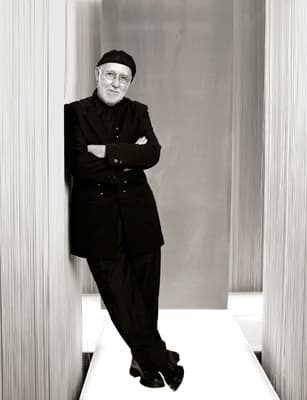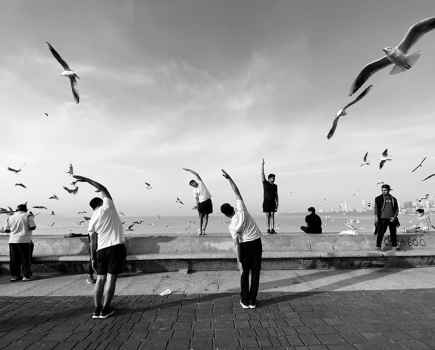Image: Albert Watson by Gloria Rodriguez
Albert Watson is one of the most prolific and successful editorial and commercial photographers of the past 40 years. He has created iconic celebrity portraits and hundreds of covers for Vogue magazine. He has also photographed numerous high-profile advertising campaigns and film-poster images. In recent years he has focused mainly on gallery exhibitions and print sales, and has successfully made the transition from commercial to fine-art photography.
Watson has a reputation both as a perfectionist and a workaholic, and he produces work with a striking, graphic quality. ‘A lot of my pictures are confrontational and controlled, they’re not observational or voyeuristic,’ he told me in 2009. ‘I aim to create something that is strong, powerful, memorable, interesting and technically correct, not lazy.’ His achievements are all the more remarkable for that fact that he has been blind in one eye since birth.
He was brought up in Edinburgh, where he attended a Rudolf Steiner School that encouraged his creativity. He studied graphic design in Dundee followed by a postgraduate qualification in film and television at the Royal College of Art. The latter course included still photography and Watson says that this thorough technical training was crucial to his later career. ‘I’m not naturally a technical person, it’s something I had to learn,’ he told me. ‘I use the discipline I learned at art college every single day.’
Watson and his family moved to Los Angeles in the USA in 1970. While his wife taught at an elementary school, he began to develop his photographic career in the highly competitive fields of commercial and editorial photography.
Watson’s first success came when he was introduced to an art director at Max Factor, who gave him his first test session. The company bought two images from the shoot. Within a year he opened his own studio and his work began to appear in fashion magazines, including Mademoiselle and Harper’s Bazaar. In 1976 he was given his first assignment for Vogue magazine and he moved to New York.
Since then, Watson has had a very busy career and his creative skills have remained in constant demand. From the late 1970s to the ’90s, the majority of his commissioned work was fashion photography; to date, his images have appeared on more than 250 Vogue covers. He has also shot numerous assignments for magazines such as Time, Rolling Stone and Interview, and has been responsible for shooting high-profile film posters, including The Da Vinci Code, Kill Bill and Chicago.
However, his output hasn’t been confined to stills work. In 1992, he founded his own television production company and since then he has directed more than 650 television commercials.
Watson’s photography is always carefully crafted and meticulously planned to the smallest technical detail. He says he thrives on doing a variety of photographic work, from fashion to still life and from urban landscape to celebrity portraiture. His work is as likely to be found on a magazine cover or film poster as it is on the walls of major museums and galleries around the world.
‘The dominant thing for me is that I have a passion for pure photography, pure photographic imagery,’ Watson says. ‘That’s why I do so many different things. I didn’t want to just become a landscape guy or a fashion guy; I wanted to photograph everything I could.’
 Image: Kate Moss, Marrakech, Morocco, 1993 © Albert Watson
Image: Kate Moss, Marrakech, Morocco, 1993 © Albert Watson
The archives at his New York studio are filled with hundreds of thousands of images, yet inevitably a few have become particularly associated with his name. One is a nude image of supermodel Kate Moss, which he shot at the end of a rooftop assignment in Morocco for German Vogue in 1993. A print of this image sold at auction in 2008 for $108,000. Another is a double exposure of Mick Jagger and a leopard, in which the two faces merge seamlessly and was achieved without the aid of Photoshop.
Today, despite the revolution in digital kit, Watson still prefers shooting on large-format film cameras, although he scans and prints the results digitally. ‘When I’m working on 4×5 cameras and 8×10, I’ve been a photographer so long that I know when I have the shot,’ he said in a 2008 interview. ‘So I don’t quite see the point of digital for me.
‘Of course, I know why someone would do it. But, for me, film is more beautiful. If you take a scan of 8×10 film and put it beside the file from the biggest file you could possibly make from a digital back camera, the 8×10 film scan is more beautiful, more charismatic.’
Watson turned 68 this year, but is still working hard; since 2004 he has produced many major gallery and museum shows of his work around the US and Europe. Two books of his photographs have been published in 2010 alone: UFO: Unified Fashion Objectives, a 40-year career retrospective, and Strip Search, Watson’s personal behind-the-scenes portrait of the city of Las Vegas.
Watson’s strong work ethic, combined with his enjoyment of solving practical problems and his obsession with image-making, means there’s little chance of his output slowing down.
‘My first love will always be photography,’ he said when explaining his passion for the medium in 2008. ‘When I get behind the camera, time disappears and I enter a state of euphoria.’
 Image: Monkey with gun, New York City, 1992 © Albert Watson
Image: Monkey with gun, New York City, 1992 © Albert Watson
Biography
- 1942 Albert Watson is born in Edinburgh. His mother is a PE teacher and his father a professional boxer. He is blind in one eye from birth
- 1962-66 Studies graphic design at the Duncan of Jordanstone College of Art & Design in Dundee
- 1966-69 Studies film and television at the Royal College of Art in London
- 1970 Moves to Los Angeles, California, and begins shooting photographs professionally
- 1971 Opens his own photographic studio and gradually begins working for fashion magazines including Mademoiselle, GQ and Harper’s Bazaar
- 1975 Wins a Grammy Award for his photography on the cover of the Mason Proffit album Come and Gone
- 1976 First commission for Vogue magazine. Moves permanently to New York City
- 1986 Invited to be the official photographer at the wedding of Prince Andrew and Sarah Ferguson
- 1994 Publishes his first book, Cyclops
- 2000 Named ‘one of the 20 most influential photographers of all time’ by Photo District News
- 2006 Wins a Lucie Award for Outstanding Achievement in Advertising Photography
- 2010 Awarded the prestigious Centenary Medal by the Royal Photographic Society for his contribution to photography
Books and Websites
Books: Albert Watson (published by Phaidon, 2007) offers an overview of the photographer’s personal and professional work. His new books UFO: Unified Fashion Objectives and Strip Search are published by PQ Blackwell in association with Abrams.
Websites: Watson’s official website is www.albertwatson.net and it features a wide selection of his work, a career profile and a list of his publications. It also includes interviews with him, both in print and on video. More interviews can be found on www.youtube.com.








